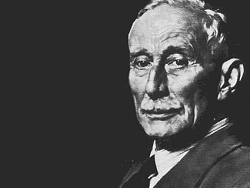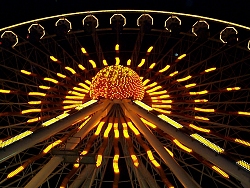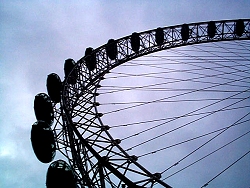|
.
Although he
never stopped believing in the potential of his invention, he quickly
lost faith in his own abilities as an engineer and salesman. Having lost
a great deal of his fortune trying to sell wheels to other locations, he
moved into a string of cheap hotels, where his depression spiralled. He
died alone and bankrupt on Nov 21, 1896 in Pittsburgh's Mercy Hospital,
aged 37. His ashes were held at a Pittsburgh crematorium, but nobody
ever came to collect them. His wife had left him a few months before his
death, and they had no children.
|

|
| Cecil
Booth (pictured) along with Walter Bassett built the Ferris Wheel
that ran at Earl's Court from 1895 |
In the last
months of his life, the Ferris Wheel began to enjoy a renaissance, at
least in Europe, thanks to an Englishmen Cecil Booth and Walter Bassett.
Between them, they provided a replica Ferris Wheel for Earl’s Court,
which stood from 1895 to 1906 (joined in 1904 by Sir Hiram Maxim’s
original Flying Machines ride).
Here the
ride, renamed “The Big Wheel” was immensely popular; so much so in
fact, that it even provided the inspiration for a music-hall song,
called “I’ve Got The Five Pound Note”, this being the compensation
given to anyone stuck on the wheel during a breakdown. This gave the
wheel an unwarranted reputation for unreliability, which worked to the
owners’ advantage, as many willingly boarded the ride in the hope of
being stranded and receiving this grand sum.
1896 was to
prove a busy year for Booth and Bassett. They were first called upon to
build a wheel for the Winter Gardens in Blackpool, never a town to miss
out on a new way of entertaining its visitors. “The Great Wheel”, as
it was known, was not very profitable, partly because the sea air made
maintenance more costly than previous wheels, but also because it was
dwarfed by the nearby Blackpool Tower, which made the wheel appear less
grandiose to visitors.
When
construction finished in Blackpool, Booth and Bassett moved on to
Vienna’s Prater, to build the “Reisenrad” wheel to act as a focal
point of the celebrations
of Emperor Franz Josef I’s golden jubilee.
The Reisenrad opened in 1897, and remains in operation to this day,
having never lost its status as one of the defining icons of the
Austrian capital.
On
the other side of the Atlantic, the same year saw Illinois-born engineer
William Sullivan opened the first fully-portable wheel in Jacksonville,
Florida. Sullivan’s firm, the Eli Bridge Company, still makes Ferris
Wheels for theme parks and showmen to this day.
If there
was a certain irony in Blackpool hosting a replica Ferris Wheel in the
shadow of a replica Eiffel Tower, then there was more to come as the
French decided to commission a replica Ferris Wheel for the Paris
Exposition of 1900. They were given a copy of Ferris’s plans, and
rebuilt it to the tiniest detail, where it proved to be a roaring
success all over again.
|

|
| The
Ferris Wheel is a commodity few parks can be without |
While these
replicas were drawing the crowds, the original Ferris Wheel suffered a
more ignominious fate. Seized by the Chicago Sheriff’s Office soon
after Ferris’s bankruptcy, it was dismantled and transported to New
Orleans, where it would feature at 1904’s Louisiana Purchase
Exposition. Compared to Chicago, however, ticket sales were low, and the
Wheel was destroyed in 1906.
Since
Ferris’s death, his invention has managed to maintain its appeal, and
few major theme parks today are without a wheel of some description. The
great exception to this, of course, has been the UK parks, most of which
are blighted with restrictions on how high their rides are allowed to
be. Most are unable to build above tree height, which often renders the
idea pointless, as it would mean that the views from the top of the
wheel would be severely restricted.
Although
many showmen continued to travel Eli type wheels, it seemed that the UK
was destined to remain the one country not to fall in love with the
larger Ferris Wheel, but then something quite bizarre happened that
would turn Britain into debatably the Ferris Wheel capital of the world
– the British Airways London Eye.
In 1993
husband and wife architect team David Marks and Julia Barfield decided
to enter a competition to design a new landmark for London, and came up
with the idea to build the world’s biggest Ferris Wheel on the south
bank of the Thames. They didn’t win the competition; in fact nobody
did, as the judges deemed that none of the ideas were good enough to
carry out. Nevertheless, the couple believed in the idea, and began
campaigning to make it a reality.
|

|
| London
Eye was initially built with a lifespan of five years -
Livingstone has since increased this to 27 years. |
In
retrospect, it is difficult to imagine a more outlandish scheme than to
build a gleaming white 443ft modernistic wheel amongst such historic
buildings as the Houses of Parliament and St Paul’s Cathedral, or how
they ever even hoped to win support for the idea.
Somehow,
though, win it they did, albeit with a proviso from Lambeth council that
they reserve the right to order its removal after five years if it
failed to win the public’s affection. That deadline passed at the end
of 2004, by which time it had become so popular as to become one of the
most recognisable landmarks not only of London, but of Britain. Continues...
|